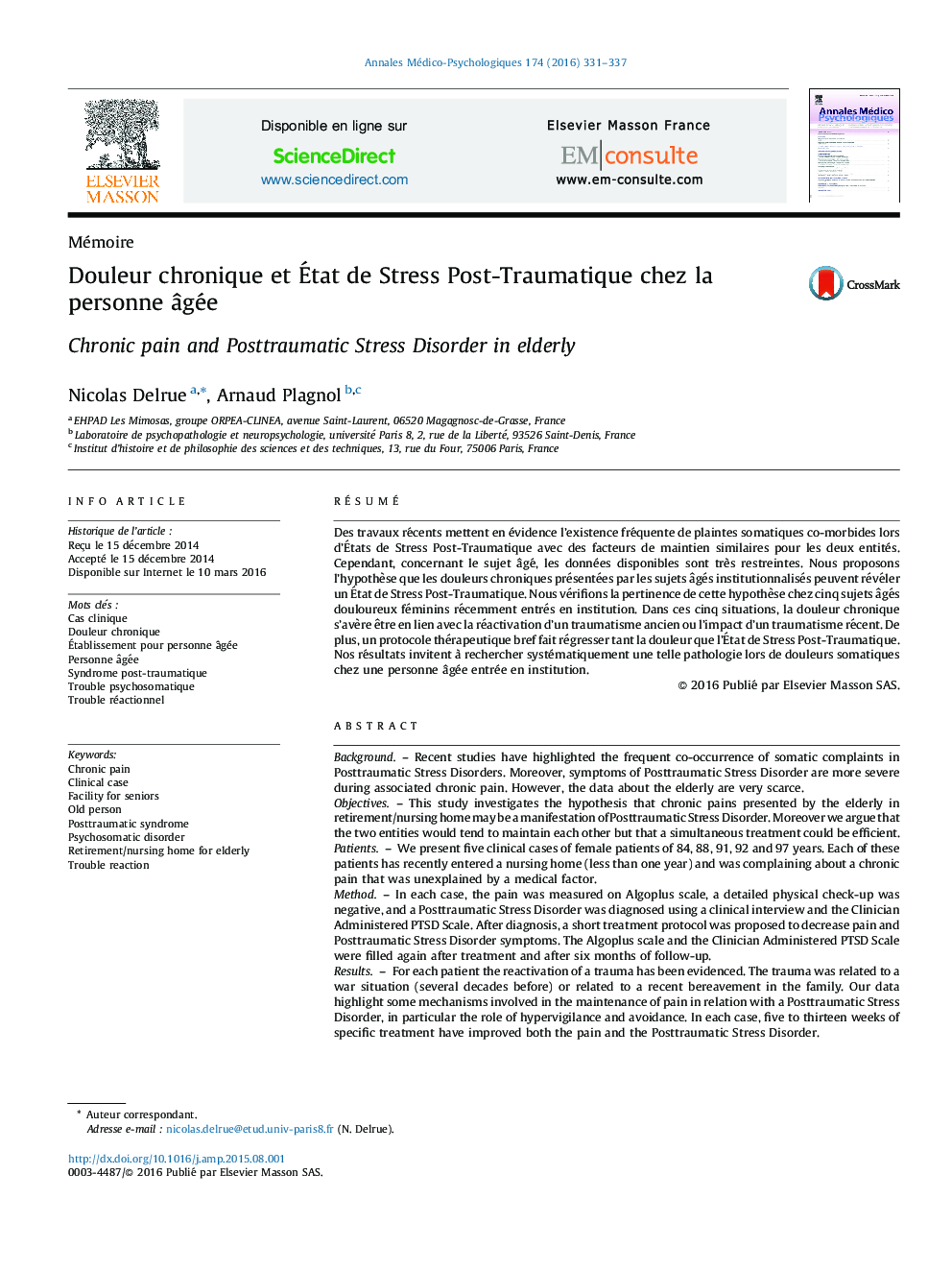| Article ID | Journal | Published Year | Pages | File Type |
|---|---|---|---|---|
| 312208 | Annales Mdico-psychologiques, revue psychiatrique | 2016 | 7 Pages |
RésuméDes travaux récents mettent en évidence l’existence fréquente de plaintes somatiques co-morbides lors d’États de Stress Post-Traumatique avec des facteurs de maintien similaires pour les deux entités. Cependant, concernant le sujet âgé, les données disponibles sont très restreintes. Nous proposons l’hypothèse que les douleurs chroniques présentées par les sujets âgés institutionnalisés peuvent révéler un État de Stress Post-Traumatique. Nous vérifions la pertinence de cette hypothèse chez cinq sujets âgés douloureux féminins récemment entrés en institution. Dans ces cinq situations, la douleur chronique s’avère être en lien avec la réactivation d’un traumatisme ancien ou l’impact d’un traumatisme récent. De plus, un protocole thérapeutique bref fait régresser tant la douleur que l’État de Stress Post-Traumatique. Nos résultats invitent à rechercher systématiquement une telle pathologie lors de douleurs somatiques chez une personne âgée entrée en institution.
BackgroundRecent studies have highlighted the frequent co-occurrence of somatic complaints in Posttraumatic Stress Disorders. Moreover, symptoms of Posttraumatic Stress Disorder are more severe during associated chronic pain. However, the data about the elderly are very scarce.ObjectivesThis study investigates the hypothesis that chronic pains presented by the elderly in retirement/nursing home may be a manifestation of Posttraumatic Stress Disorder. Moreover we argue that the two entities would tend to maintain each other but that a simultaneous treatment could be efficient.PatientsWe present five clinical cases of female patients of 84, 88, 91, 92 and 97 years. Each of these patients has recently entered a nursing home (less than one year) and was complaining about a chronic pain that was unexplained by a medical factor.MethodIn each case, the pain was measured on Algoplus scale, a detailed physical check-up was negative, and a Posttraumatic Stress Disorder was diagnosed using a clinical interview and the Clinician Administered PTSD Scale. After diagnosis, a short treatment protocol was proposed to decrease pain and Posttraumatic Stress Disorder symptoms. The Algoplus scale and the Clinician Administered PTSD Scale were filled again after treatment and after six months of follow-up.ResultsFor each patient the reactivation of a trauma has been evidenced. The trauma was related to a war situation (several decades before) or related to a recent bereavement in the family. Our data highlight some mechanisms involved in the maintenance of pain in relation with a Posttraumatic Stress Disorder, in particular the role of hypervigilance and avoidance. In each case, five to thirteen weeks of specific treatment have improved both the pain and the Posttraumatic Stress Disorder.ConclusionsThese results suggest the interest of a systematic search for a Posttraumatic Stress Disorder when the clinician encounters a painful patient who has recently entered a nursing home, especially for the age groups concerned with war and deportation.
